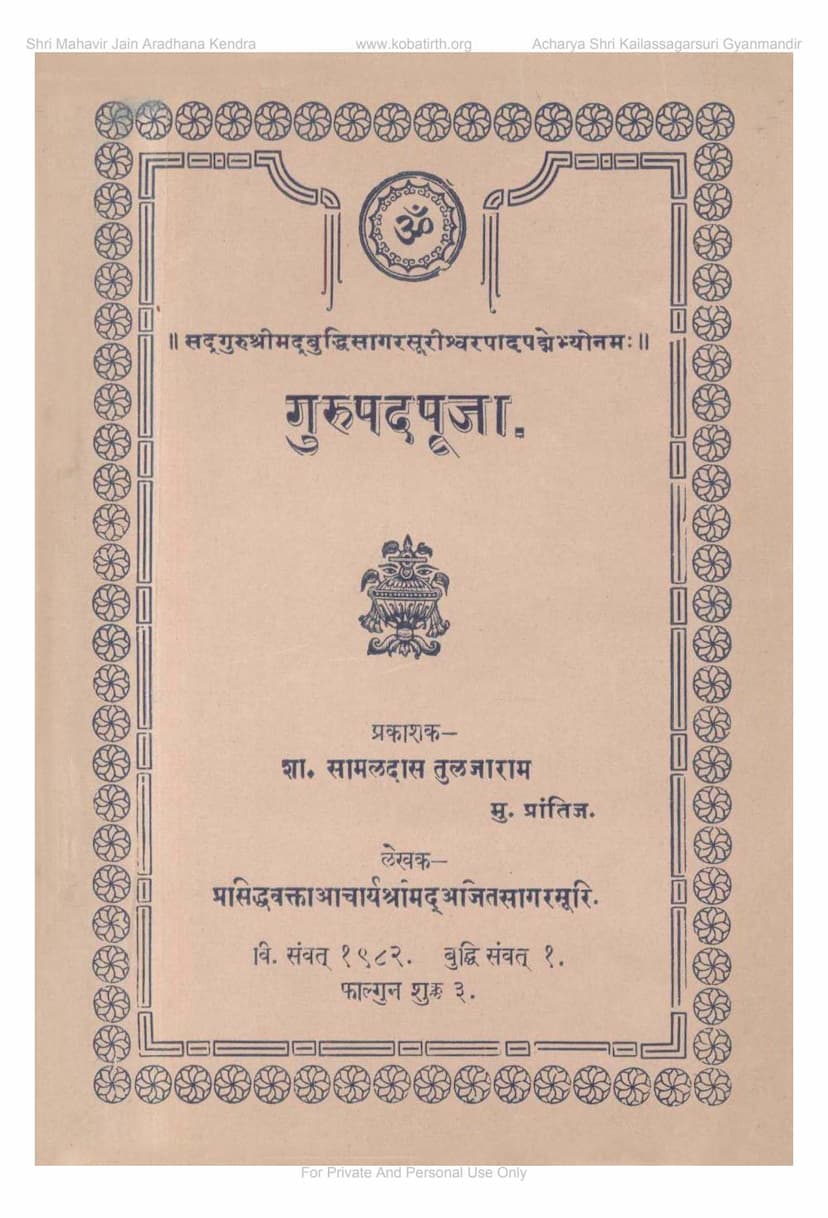Gurupad Pooja
Added to library: September 1, 2025

Summary
Here is a comprehensive summary of the Jain text "Gurupad Pooja" by Ajitsagarsuri, based on the provided pages:
Title: Gurupad Pooja (Worship of the Guru's Foot/Station) Author: Acharya Shri Ajitsagarsuri Publisher: Shamaldas Tuljaram Prantij Publication Year: Vikram Samvat 1982 (Intelligence Samvat 1)
Core Message and Purpose:
The central theme of "Gurupad Pooja" is the profound importance and veneration of the spiritual guide (Guru) in the Jain tradition. The text emphasizes that true spiritual liberation (Moksha) and self-realization are impossible without the guidance of a true Guru. It argues that even with physical sight, ignorance can blind individuals, making them unable to perceive truth. Therefore, the Guru's guidance is paramount, as there is no higher truth or entity than the Guru ("Naasti Tatvam Guroh Param").
Key Arguments and Teachings:
- The Guru as the Sole Path to Liberation: The text asserts that the attainment of self-knowledge and spiritual practice is the primary duty of every soul. However, this self-knowledge cannot be achieved without true understanding, which is only possible through the grace and teachings of a Sadguru (a true Guru).
- Guru's Grace and Power: The book highlights that following the Guru's commands leads to Moksha. The Guru's pleasure brings about extraordinary powers (Ashta Siddhi), and without devotion to the Guru, even learning and knowledge are fruitless. The influence of the Guru is described as immeasurable and miraculous.
- The Guru as the Ultimate Refuge: In the vast and perilous ocean of existence (Samsara), while many false guides may appear, the true, truthful, and moderate Guru is a rare guide. The Guru is presented as the sole refuge for virtuous beings lost in the dense forest of Samsara, not only in the present but also in the past and future.
- The Guru as the Dispeller of Ignorance: Similar to how a lamp dispels darkness and illuminates objects, the Guru, through the practice of the "Ratnatraya" (Right Faith, Right Knowledge, Right Conduct), dispels the darkness of delusion and illuminates both themselves and others.
- The Guru's Supremacy and Worship: The text declares the Guru as the most venerable in the universe for imparting knowledge. It reiterates that the Guru's glory is extensively praised in scriptures.
Commemoration of Acharya Buddhisagar Surishwarji:
A significant portion of the text is dedicated to commemorating the passing of Acharya Shri Buddhisagar Surishwarji. It mentions that he attained the highest state (Paramapad) on Tuesday, Jyeshtha Krishna 3, Vikram Samvat 1981, in Vijapur. The text notes the widespread grief and tributes received from across the country, as documented in letters and telegrams sent to the author's Guru. It also describes the construction of a beautiful memorial temple in Vijapur, where the Guru's idol was installed for worship.
The "Gurupad Pooja" Ritual:
The book provides detailed instructions on how to perform the "Gurupad Pooja" (worship of the Guru's foot/station). This involves:
- Establishing the Guru's Presence: This can be done by placing the Guru's sandals (paduka), footprints, or images.
- Offerings: The ritual includes offerings of water (Jal), sandalwood (Chandan), flowers (Pushpa), incense (Dhoop), lamps (Deep), unbroken rice (Akshata), and sweets/food (Naivedya) and fruits (Phala).
- Similarities to Deity Worship: The procedures for offering these items are similar to those used in the worship of Jain Tirthankaras (Jin Pratima).
- Veneration of Gurus: The text clarifies that the idols and footprints of Acharyas, Upadhyayas, and Munis are worthy of worship, similar to Jin idols, as they are integral to the Panch Parmeshthi (five supreme beings).
- Devotional Practices: The book encourages performing the pooja with devotion on the day of a Guru's passing. It also suggests honoring all fellow devotees, offering meals, organizing devotional songs and performances, and extending special service to Sadhus and Sadhvis. Reading the Guru's life story (Gurucharitra) and supporting the printing of religious books are also recommended.
Structure of the "Gurupad Pooja":
The pooja is structured as an eight-fold worship, each stage associated with a specific offering and devotional intent:
- Jal Pooja (Water Offering): Symbolizing purity and the dispelling of worldly suffering.
- Chandan Pooja (Sandalwood Offering): Representing the cooling and soothing effect of the Guru's presence, dispelling the heat of worldly passions.
- Pushpa Pooja (Flower Offering): Symbolizing auspicious qualities and devotion.
- Dhoop Pooja (Incense Offering): Representing the dispelling of ignorance and the spreading of virtuous fragrance.
- Deep Pooja (Lamp Offering): Symbolizing the dispelling of the darkness of ignorance and the illumination of knowledge.
- Akshata Pooja (Unbroken Rice Offering): Symbolizing auspiciousness, completeness, and the Guru's lasting influence.
- Naivedya Pooja (Sweet/Food Offering): Representing the offering of one's pure devotion and dedication.
- Phala Pooja (Fruit Offering): Symbolizing the fruition of spiritual practice and the ultimate rewards of liberation.
Content and Style:
The text is written in Gujarati and employs a devotional and pedagogical style. It uses verses (couplets, dohas, dhal – a form of devotional song), prayers (mantras), and narratives to convey its message. The language is poetic and aimed at inspiring devotion and understanding of the Guru's significance.
Overall Significance:
"Gurupad Pooja" is a significant Jain text that not only outlines a ritual for honoring spiritual preceptors but also deeply articulates the foundational role of the Guru in the Jain path to spiritual perfection. It serves as a guide for devotees to cultivate devotion and seek the wisdom necessary for liberation.